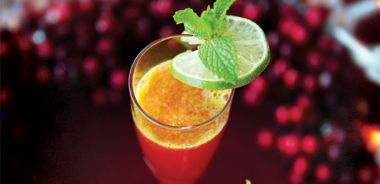Citrus Pomegranate Sunrise

Chock full of healthy cheer with an option of either sparkling soda or champagne, this holiday treat is a nose tickler for everyone. The lovely pomegranate juice blushes from the bottom of the glass for a dramatic effect.
3 large yellow-fleshed grapefruits
4 navel oranges
2 limes, zest and juice
3 cups (750 mL) chilled champagne or sparkling water
2 cups (500 mL) chilled pomegranate juice
Mint
8 thin lime wedges
Into 2 L pitcher squeeze juice from grapefruits and oranges. Add lime zest and juice and sparkling water and gently stir to blend. Divide among 8 chilled wine flutes or narrow glasses. Pour 1/4 cup (60 mL) pomegranate juice into each. Garnish with mint and lime wedge. Serve immediately.Serves 8.
Each serving contains: 101 calories; 1 g protein; 0 g total fat (0 g sat. fat, 0 g trans fat); 26 g carbohydrates (21 g sugars, 3 g fibre); 6 mg sodium
source: "Festive Brunch fo Savour", alive #362, December 2012





